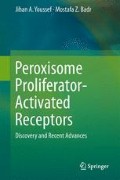Abstract
Using electron microscopy, microbodies were first discovered in 1954 in mouse renal cells by Rhodin (Afzelius 1965). Later in 1966, De Duve and Baudhuin were the first to isolate these organelles from rat liver and, based on biochemical studies, termed them peroxisomes (Schrader and Fahimi 2008). Peroxisomes were later found in all eukaryotic cells with the exception of mature erythrocytes and sperms (Schrader and Fahimi 2008; Fidaleo 2010). Although all peroxisomes have common metabolic pathways, unique cell- and/or tissue-specific peroxisomal functions may also exist. Future discovery of various peroxisomal marker proteins as well as more sensitive detection techniques such as mass spectrometry-based proteomics should provide insights toward better understanding of peroxisomal functions in different tissues and species (Islinger et al. 2010).
Access this chapter
Tax calculation will be finalised at checkout
Purchases are for personal use only
References
Afzelius BA (1965) The occurrence and structure of microbodies: a comparative study. J Cell Biol 26:835–843
Baes M, Aubourg P (2009) Peroxisomes, myelination and axonal integrity in the CNS. Neuroscientist 15:367–379
Braverman NE, Moser AB, Steinberg SJ (2010) Rhizomelic chondrodysplasia punctata type 1. In: Pagon RA, Bird TC, Dolan CR, Stephens K, eds
Coulter-Mackie MB, White CT, Hurley RM, Chew BH, Lange D (2011) Primary hyperoxaluria type 1. In: Pagon RA, Bird TD, Dolan CR, Stephens K, Adam MP (eds) GeneReviews™ [Internet]. University of Washington, Seattle, WA, 1993–2002. Jun 19 [updated 2011 Nov 17]
Ferdinandusse S, Denis S, Clayton PT, Graham A, Rees JE, Allen JT, McLean BN, Brown AY, Vreken P, Waterham HR, Wanders RJ (2000) Mutations in the gene encoding peroxisomal alpha-methylacyl-CoA racemase cause adult-onset sensory motor neuropathy. Nat Genet 24:188–191
Fidaleo M (2010) Peroxisomes and peroxisomal disorders: the main facts. Exp Toxicol Pathol 62:615–625
Foxworthy PS, White SL, Hoover DM, Eacho PL (1990) Effect of ciprofibrate, bezafibrate and LY171883 on peroxisomal beta-oxidation in cultured rat, dog and rhesus monkey hepatocytes. Toxicol Appl Pharmacol 104:386–394
Góth L, Rass P, Páy A (2004) Catalase enzyme mutations and their association with diseases. Mol Diagn 8:141–149
Hara-Kuge S, Fujiki Y (2008) The peroxin Pex14p is involved in LC3-dependent degradation of mammalian peroxisomes. Exp Cell Res 314:3531–3541
Huybrechts S, Van Veldhoven P, Brees C, Mannaerts GP, Los GV, Fransen M (2009) Peroxisome dynamics in cultured mammalian cells. Traffic 10:1722–1733
Islinger M, Cardoso MJR, Schrader M (2010) Be different, the diversity of peroxisomes in the animal kingdom. Biochim Biophys Acta 1803:881–897
Islinger M, Grille S, Fahimi HD, Schrader M (2012) The peroxisome: an update on mysteries. Histochem Cell Biol 137:547–574
Jones JM, Morrell JC, Gould SJ (2004) PEX19 is a predominantly cytosolic chaperone and import receptor for class 1 peroxisomal membrane proteins. J Cell Biol 164:57–67
Lake BG, Gray TJ (1985) Species differences in hepatic peroxisome proliferation. Biochem Soc Trans 13:859–861
McNew JA, Goodman JM (1994) An oligomeric protein is imported into peroxisomes in vivo. J Cell Biol 127:1245–1257
McNew JA, Goodman JM (1996) The targeting and assembly of peroxisomal proteins: some old rules do not apply. Trends Biochem Sci 21:54–58
Mukaiyama H, Baba M, Osumi M, Aoyagi S, Kato N, Ohsumi Y, Sakai Y (2004) Modification of a ubiquitin-like protein Paz2 conducted micropexophagy through formation of a novel membrane structure. Mol Biol Cell 15:58–70
Poll-The BT, Gärtner J (2012) Clinical diagnosis, biochemical findings and MRI spectrum of peroxisomal disorders. Biochim Biophys Acta 1822:1421–1429
Reddy JK, Krishnakantha TP (1975) Hepatic peroxisome proliferation: induction by two novel compounds structurally unrelated to clofibrate. Science 190:787–789
Richert L, Price S, Chesne C, Maita K, Carmichael N (1996) Comparison of induction of hepatic peroxisome proliferation by the herbicide oxadiazon in vivo in rats, mice and dogs and in vitro in rat and human hepatocytes. Toxicol Appl Pharmacol 141:35–43
Rucktäschel R, Halbach A, Girzalsky W, Rottensteiner H, Erdmann R (2010) De novo synthesis of peroxisomes upon mitochondrial targeting of Pex3p. Eur J Cell Biol 89:947–954
Rucktäschel R, Girzalsky W, Erdmann R (2011) Protein import machineries of peroxisomes. Biochim Biophys Acta 1808:892–900
Schrader M, Fahimi HD (2008) The peroxisome: still a mysterious organelle. Histochem Cell Biol 129:421–440
Steinberg SJ, Dodt G, Raymond GV, Braverman NE, Moser AB, Moser HW (2006) Peroxisome biogenesis disorders. Biochim Biophys Acta 1763:1733–1748
Thoms S, Gärtner J (2012) First PEX11β patient extends spectrum of peroxisomal biogenesis disorder phenotypes. J Med Genet 49:314–316
Till A, Lakhani R, Burnett SF, Subramani S (2012) Pexophagy: the selective degradation of peroxisomes. Int J Cell Biol 2012:512721
Wanders RJ, Waterham HR (2005) Peroxisomal disorders I: biochemistry and genetics of peroxisome biogenesis disorders. Clin Genet 67:107–133
Wanders RJ, Ferdinandusse S, Brites P, Kemp S (2010) Peroxisomes, lipid metabolism and lipotoxicity. Biochim Biophys Acta 1801:272–280
Wanders RJ, Komen J, Kemp S (2011) Fatty acid omega-oxidation as a rescue pathway for fatty acid oxidation disorders in humans. FEBS J 278:182–194
Weller S, Gould SJ, Valle D (2003) Peroxisome biogenesis disorders. Annu Rev Genomics Hum Genet 4:165–211
Yokota S (2003) Degradation of normal and proliferated peroxisomes in rat hepatocytes: regulation of peroxisomes quantity in cells. Microsc Res Tech 61:151–160
Yokota S, Fahimi HD (2009) Degradation of excess peroxisomes in mammalian liver cells by autophagy and other mechanisms. Histochem Cell Biol 131:455–458
Zutphen T, Veenhuis M, van der Klei I (2008) Pex14 is the sole component of the peroxisomal translocon that is required for pexophagy. Autophagy 4:63–66
Author information
Authors and Affiliations
Rights and permissions
Copyright information
© 2013 Springer Science+Business Media New York
About this chapter
Cite this chapter
Youssef, J.A., Badr, M.Z. (2013). History of PPAR Discovery. In: Peroxisome Proliferator-Activated Receptors. Humana Press, Totowa, NJ. https://doi.org/10.1007/978-1-62703-420-3_2
Download citation
DOI: https://doi.org/10.1007/978-1-62703-420-3_2
Published:
Publisher Name: Humana Press, Totowa, NJ
Print ISBN: 978-1-62703-419-7
Online ISBN: 978-1-62703-420-3
eBook Packages: Biomedical and Life SciencesBiomedical and Life Sciences (R0)

